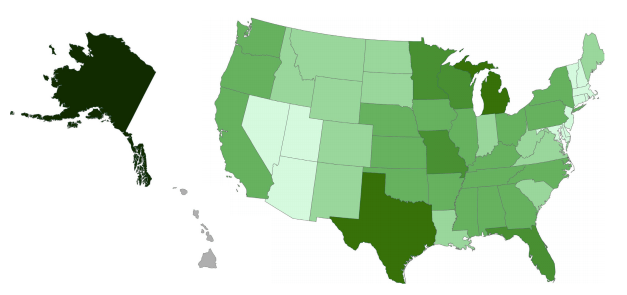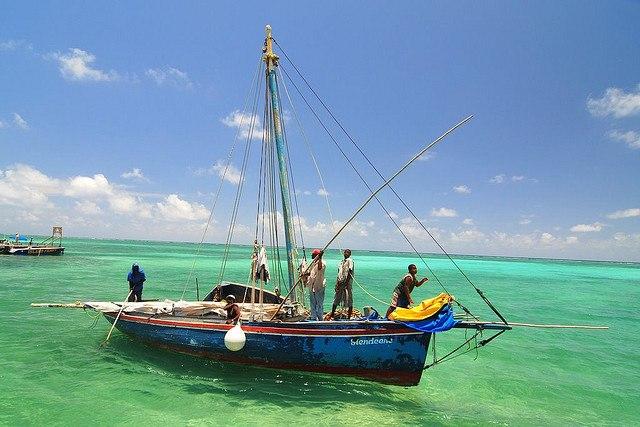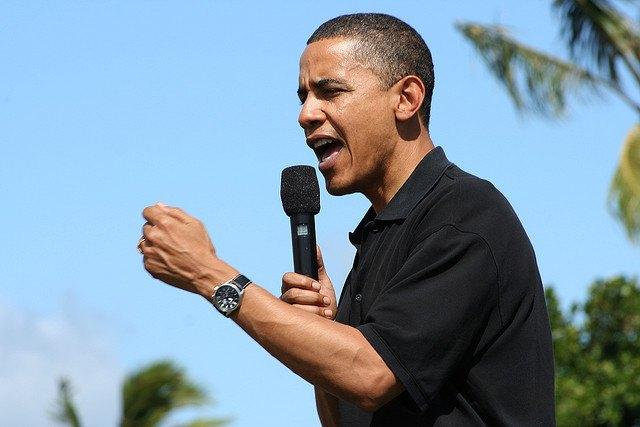Twitter Chat Recap: Global Footprint Network at #USAfootprint


On July 14th, otherwise known as Ecological Deficit Day in the United States, Earth Economics and Global Footprint Network joined TriplePundit for a chat at #USAfootprint. This unique Twitter Chat focused on the significance of July 14th, marking the day the U.S. has busted its annual ecological budget, utilizing more resources and services than the nation’s ecosystems can regenerate within the full year.
The population of the United States is using twice the renewable natural resources and services that can be regenerated within its borders. But which states are the most resource-constrained? And which states are the most resource-abundant?
On July 14, Global Footprint Network released its first analysis of the ecological footprint of the 50 United States in a report called, State of the States: A New Perspective on the Ecological Wealth of Our Nation.
Topics that we explored during the #USAfootprint conversation included: how ecological footprint accounting measures a population’s demand for resources, how carbon’s contribution to climate change poses varying risks to different states, and how decision-makers can manage natural capital more sustainably. A synopsis of the full conversation is here.
FEATURED GUESTS:
- Mathis Wackernagel (@EndOvershoot) — President & Co-Founder, Global Footprint Network
- David Batker (@EarthEconomics) — Executive Director & Co-Founder, Earth Economics
- Nick Aster (@NickAster) — TriplePundit Founder and Publisher
- Marissa Rosen (@MarissaR1) — TriplePundit Director of Social Media
- Jen Boynton (@JenBoynton) — TriplePundit Editor-In-Chief
About Earth Economics Earth Economics is a nonprofit, nonpartisan, economic research, and policy organization located in Tacoma, Wash. Earth Economics provides robust, science-based, ecologically sound economic analysis, policy recommendations and tools to positively transform regional, national and international economics, and asset accounting systems. The organization’s goal is to help communities shift away from the failed economic policies of the past, towards an approach that is both economically viable and environmentally sustainable.
Media Contacts:
Ronna Kelly, Communications Director, Global Footprint Network
+1 (510) 839-8879 x 302 | +1 (510) 834-2563 (cell)
[email protected]
Amanda Diep, Communications Associate, Global Footprint Network
+1 (510) 839-8879 x 309 | +1 (510) 834-2563 (cell)
[email protected]
CVS Health Quits US Chamber of Commerce in Another Principled Stand on Tobacco


A few weeks ago we ran a story about CVS Health's principled stand on tobacco. The company basically gave up $2 billion in annual sales of a product that was inconsistent with its mission of “helping people on their path to better health.”
We spoke with Eileen Howard Boone, SVP of corporate social responsibility and philanthropy at CVS. She told us that, in essence, it made no sense -- as the company was making efforts to provide “chronic disease management to help patients with high blood pressure, high cholesterol and diabetes,” on one hand -- to keep selling tobacco products that have an adverse health impact on each of these conditions, on the other.
Now the retail chain has taken another step to clarify its position on the matter. When it was revealed that the U.S. Chamber of Commerce (USCC) was gearing up for a global lobbying campaign against anti-smoking laws, CVS resigned its membership in the chamber.
The New York Times described a number efforts by the chamber, working in conjunction with international affiliates, to attack measures that would ban or restrict tobacco sales. In one example, a case being heard in a Ukrainian courtroom, argued on behalf of the local USCC affiliate, attempts to challenge the right of the Australian government to enact smoking bans on its own soil. (Expect to see a lot more of these once the Trans-Pacific Partnership is enacted.) In fact, Thomas J. Donohue, the head of the U.S. Chamber of Commerce, has defended the tobacco industry's right to sue under future international treaties including TPP.
Supporting the tobacco industry has apparently become a priority of the USCC. The rest of the world has come together, with a total of 179 countries signing on to a treaty negotiated by the World Health Organization (WHO) that mandates anti-smoking measures and attempts to reign in the power and influence of the tobacco industry. Three countries have not ratified the treaty. Cuba, famous for their cigars; Haiti, the poorest nation in our hemisphere; and the U.S. The industry, with its very deep pockets here ($47 billion in cigarette sales last year), has its back to the wall, as many would say it should, and the unflagging support of an influential organization whose mission is to promote American business around the world, apparently without regard for what that business might be.
USCC won't comment on whether it specifically targeted anti-smoking legislation. Its only comment was: “The chamber regularly reaches out to governments around the world to urge them to avoid measures that discriminate against particular companies or industries, undermine their trademarks or brands, or destroy their intellectual property. We’ve worked with a broad array of business organizations at home and abroad to defend these principles.”
However, Dr. Vera Luiza da Costa e Silva, the head of the Secretariat that oversees the WHO treaty, said: “[The chamber] represent the interests of the tobacco industry. They are putting their feet everywhere where there are stronger regulations coming up.”
So, let’s hear it for CVS for once again taking a principled stand, and shame on the USCC for its seedy interventions. After all, if we call a spade a spade, tobacco companies are little better than dope dealers selling drugs to addicts, who in many cases are incapable of resisting the urge to smoke and will pay whatever price is required to satisfy their craving, no matter the cost to their personal finances, their health or the health of those around them.
The question is: Why has the gap between the interests of American business, as described by the USCC, and the interests of the common good grown so wide? At a time when so many businesses are beginning to step up and consider their public responsibility as central to their core missions, the USCC seems to be mired in the past, chasing a Gilded Age vision of unlimited wealth for the very few, regardless of the social consequences. Perhaps that’s why so many progressive companies are dropping out.
Besides CVS leaving over the tobacco issue, construction firm Skanska left over their resistance to green building practices. Apple, Yahoo, Pacific Gas and Electric, are among those who quit due to the chamber’s stance on environmental issues. Maybe it’s time for the chamber to open a window and let the smoke out, so that they too can see what’s going on.
Image credit: Julie: Flickr Creative Commons
Prison Phone Calls Prove Costly for Family Members


The private phone business going on in American prisons leaves family members and friends of the incarcerated emptying their pockets for just minutes of conversation. In some states, like Pennsylvania, a 15-minute call to certain prisons can cost an upward of $12 — it would be around 60 cents for a similar non-prison call.
The costs — much like service charges buried in payments for purchasing sporting or concert tickets online — feature fees that drive the cost up even higher for family members trying to stay in contact. Seventy percent of the private phone business in prisons is owned and managed by just two companies, Global Tel-Link Corp. (50 percent) and Securus Technologies (20 percent), allowing the rivals to keep prices relatively high because of the lack of competition in the billion-dollar industry.
Global Tel-Link contributed to nearly half of the country’s 500 million prison phone calls, totaling more than 6 billion minutes in 2014. If each of the 215 million prison calls came with a price tag of $12 per 15 minutes, Global Tel-Link would have made $2.58 billion last year, without factoring in business operations.
Securus, according to a New York Times report and company documents, “imposes dozens of fees for call and basic services, including establishing, maintaining and closing an account.” The company insists it needs to include these fees in order to maintain its operating margins, which helps oversee and monitor phone calls for security purposes.
In this facet, the companies aren’t wrong. Sheriffs and county officers are paid on commission for each phone call they monitor, a price that comes right out of these private prison phone companies’ pockets. The reason Global Tel-Link and Securus are so widely recognized in the industry is because they can offer the highest commission to the officers providing the security, making prisons more interested in doing business with them.
Over the last 10 years, Securus said it generated around $1.3 billion in commissions, making it one of the most sought-after phone companies for officers and prison guards alike. Meanwhile, at a July 2014 hearing with the FCC, Securus CEO Rick Smith said the company truly doesn’t net that great of a profit annually, the International Business Times reported.
In fact, he said the same sentence three times consecutively for emphasis. “We don’t earn excessive profits,” Smith said at the hearing. “We don’t earn excessive profits. We don’t earn excessive profits. I said that three times for the egregious and abusive and predatory kinds of comments that come at us most of the time.”
But who defines “excessive” is unbeknownst to the people pouring in sometimes thousands of dollars yearly to communicate with their loved ones who are behind bars. Smith compares his “embellished profits,” as he said in 2013, to Verizon and AT&T -- companies worth $202.5 billion and $173 billion, respectively.
Contrary to Smith’s statements, the Huffington Post reported that Securus earned $114.6 million in profits in 2014, on revenues of about $404 million — turnarounds that put the company in a tier with Apple and Google. Securus representatives have since denied the accuracy of these figures, telling the FCC in a letter, “The figures set forth in the article are simply incorrect or taken in the incorrect context."
Because of the uproar and unhappiness with the current prison phone business, the FCC is expanding its 2013 regulations come fall of this year. The regulations could completely change the way the prison phone business is handled. The FCC could potentially cut the commissions paid to sheriffs and also cap unnecessary and excessive fees companies like Securus charge consumers.
Sheriffs, obviously, are unpleased with the FCC’s speculated proposal, threatening to rip the phones off the prison walls if the government limits their commissions. Global Tel-Link and Securus are also pleading for the FCC to reconsider its revisit to the regulations, claiming its charges are completely necessary to count for all the operating and quality costs for the company.
Global Tel-Link and Telmate, another prison phone company, tried to strike middle-ground with the FCC in a nine-page letter urging the commission to institute “flat rate caps” of 20 percent per minute. Although 20 cents per minute would considerably shrink the cost of the standard 15-minute conversation, advocates are pushing for numbers as low as 6 or 7 cents per minute.
The United States has the largest prison population in the world, and the number isn’t slowing down anytime soon. According to the International Center for Prison Studies, the U.S. has more than 2.2 million prisoners incarcerated, half a million more than China, the next closest country — and China has over 1 billion citizens more than the U.S. For every person swept off the streets and thrown into jail, it’s yet another $12.95 per 15 minutes for one of the leading phone companies.
Image credit: Flickr/Jason Farrar
Is a Binding Treaty the Way Forward for Business and Human Rights?


Last week in Geneva, a United Nations intergovernmental working group (IWG) held its first week-long session to debate the parameters of a potential binding treaty concerning corporate human rights abuses.
The talks are the first steps in a process marked by significant divisions between wealthy and developing nations. The IWG session did little to bridge that divide, meaning that any treaty process that moves forward is unlikely to garner the much-needed support of the world’s most powerful countries.
About the IWG and the debate surrounding a binding treaty
Last week’s session came about as a result of the U.N. Human Rights Council’s adoption, one year ago, of resolution 26/9, which established the IWG with the specific mandate to create “an international legally binding instrument to regulate, in international human rights law, the activities of transnational corporations.”
The working group is open-ended, and any U.N. Member or Observer state, specialized agency, or other intergovernmental organization, national human rights institution or non-governmental organization may attend the public meetings.
Prior to the IWG session in Geneva, there was no consensus in the international community regarding the utility of a binding treaty on transnational corporations and human rights (broadly, business and human rights, or BHR). In fact, the U.N. Human Rights Council vote to establish the IWG in the first place was sharply divided, with 20 countries voting in favor, 14 against and 13 abstaining.
Critics of a treaty, which tend to be multinational corporations, wealthy countries or strong supporters of the U.N.’s Guiding Principles on Business & Human Rights (UNGPs), say that a treaty would undermine the young UNGPs, which are a mere four years old and just starting to gain momentum. Proponents of a binding treaty, on the other hand, criticize the UNGPs for their voluntary nature and inherent weakness as “soft law.” To the UNGPs' critics, a binding treaty would give teeth to an otherwise ineffectual set of ambitions, and help close a widening justice gap in the area of BHR.
The Ruggie critique
Professor Ruggie, the architect of the UNGPs, has himself questioned the expediency of a BHR treaty ever since Ecuador proposed the idea to the U.N. Human Rights Council in 2013. To Ruggie, the doctrinal opposition of the treaty’s strongest supporters, like Ecuador, and its loudest critics, including the U.S. and the EU, is certain to undermine the process and its result. Ruggie, whose work on the UNGPs exemplifies what he calls “principled pragmatism,” points out that international law should be a tool for “collective problem-solving, not an end in itself.” Such a view holds that "the development of any international legal instrument requires a certain degree of consensus among states,” which, at the moment, is absent.Without such consensus, Ruggie sees two potential outcomes: a negotiation process that drags on for years, ultimately sputtering out and dying; or, a treaty concluded with the support of a coalition of developing countries but opposed by the wealthy home countries of most multinationals. Because a country is only bound by a treaty to which it is a signatory, a BHR treaty counting only poor countries as its members would be a “dead end, delivering nothing to individuals and communities adversely affected by corporate conduct.”
As Chip Pitts, lecturer in law at Stanford and Oxford, pointed out recently, Ruggie has acknowledged that, “at the end of the day,” there is likely to be a strong desire among the international community for “greater benchmarking, for moving from ‘good’ to ‘best’ practices and even formal codification, so that some of the ‘soft law’ products of voluntary initiatives are likely to become ‘harder’ law down the road.” What I think Professor Ruggie might add to that statement today would be: yes, a treaty may be inevitable, but we are still a long way away from its arrival.
Issues raised and resolved at the IWG session
Illustrative of the rich-poor country divide, only 9 of 28 EU member countries attended the first day of IWG consultations, and the U.S. boycotted the process entirely. Moreover, once discussions about agenda and work plan began, the EU bloc became a wedge, demanding that any future treaty encompass all enterprises – regardless of the transnational status of their activities (what I'll call "enterprise scope"). (Recall that the IWG’s mandate is limited to transnational corporations.)
The question of enterprise scope ultimately led to a three-way division among delegations. Some states, including Pakistan, China and Venezuela, remained firmly opposed to changing the scope of the treaty -- i.e., extending it beyond transnationals to include national businesses -- with the EU bloc representing the opposite view. In the middle, the likes of South Africa and Ecuador indicated a general openness to the idea of enterprise scope expansion, but were nevertheless noncommittal.
The issue of access to remedy, arguably the most significant problem facing corporate accountability advocates, likewise failed to generate agreement, reportedly leading to more questions than answers.
On the other hand, consensus was reached regarding the scope of human rights abuses to be covered by a future treaty. Rather than limiting the scope of abuses to “gross violations” of human rights, as Professor Ruggie has suggested, the delegations unanimously agreed that the “full catalogue” of human rights abuses ought to come within the scope of a BHR treaty.
Undermining this and other areas of consensus, however, was the glaring absence and/or silence on significant issues of countries like the U.S., most EU members, Japan and Australia. To be sure, a treaty that emerges without the support and input of at least some of the most influential countries in the world -- home to the most transnational companies -- is unlikely to accomplish anything.
After all, a treaty meant to deliver accountability for human rights abuses, which doesn’t cover the actors most responsible for those abuses, is little more than a piece of paper.
So, should there be a binding instrument in the first place?
Many civil society organizations certainly think so, and it’s hard to argue against any step toward corporate accountability for human rights abuses -- in theory, anyway. In practice, however, I’m inclined to agree with Ruggie and the pragmatists that the time just isn’t right. To Ruggie’s enormous credit, he was able to cobble together a vast coalition in support of the UNGPs, which have more or less been embraced by the world’s most powerful countries and corporations.
While such broad support may give one pause, it is clear that the UNGPs have already affected positive change. For example, according to a recent Economist survey, which polled 853 senior corporate executives in November and December of 2014: 83 percent of respondents agreed (74 percent of whom did so strongly) that human rights are a matter for businesses as well as governments. Moreover, 71 percent said their company’s responsibility to respect human rights went beyond simple compliance with local laws -- a crucial point and not one, I don’t think, widely accepted before the UNGPs came about.
There’s no question that there is a glaring justice gap in terms of corporate accountability for human rights abuses. Yet, the young UNGPs have already begun to change the minds of of many of those leading the world’s largest and most powerful businesses and governments. Rather than turning to focus on a separate -- though complementary -- treaty negotiation process, victims of corporate human rights abuse and their advocates would be better served focusing on further strengthening the UNGPs and seeing them more widely implemented. A binding BHR treaty makes sense -- we’re just not ready for it yet.
Image credit: Flickr/t.ap.
General Mills Writes an Animals' Declaration of Freedom


General Mills, the company behind brands like Betty Crocker, Pillsbury, Bisquick, Progresso and Hamburger Helper, announced it’s going to start requiring its egg, dairy and meat farmers to treat animals better. Slow clap.
Other companies led the way in making similar pledges earlier this year. It’s now becoming trendy to not abuse animals. Any company that still does is going to appear to customers like a person smiling with food stuck in their teeth. Walmart took positive steps earlier this year but only after the Mercy For Animals (MFA) group used six hidden-camera videos to expose its cruelty to pigs. MFA also led 150 protests at stores, an intensive ad and billboard campaign, acquired 640,000 petition signatures on Change.org, and received support from five celebrities.
Walmart then committed to end the confinement of pregnant pig moms to gestation crates, baby cows to veal crates, and egg-laying hens to battery cages. In my opinion, if you haven’t seen what this looks like, you really should.
General Mills says it’s “working to understand any potential animal welfare issues associated with fast growth of broiler chickens and turkeys.” The usage of the word "potential" there is interesting, like it's unclear whether rapidly turning a fluffy little chick into a monstrously fat chicken that's so heavy it can't walk might not have any detrimental impact.
The Humane Society isn't uncertain about the issue and says: "As consequence of unnaturally rapid growth and heavy body weight, these birds often experience skeletal and metabolic disorders that severely compromise their welfare, including lesions in the hip joint and painful leg disorders, such as angular bone deformity, tibial dyschondroplasia, and tendon rupture or slippage. Severely crippled birds may become non-ambulatory and, if unable to reach feed and water, die."
Adding to the evidence, PETA says, "By the age of 6 weeks, 90 percent of broiler chickens are so obese that they can no longer walk." Furthermore, Nick Kristof, columnist for the New York Times, stated the "Poultry Science journal has calculated that if humans grew at the same rate as modern chickens, a human would weigh 660 pounds by the age of 8 weeks." Hopefully that clears up any confusion on that issue.
Companies like General Mills that are creating ethical animal treatment goals are basing them on the international Five Freedoms of Animal Welfare established by the United Kingdom.
- The freedom from hunger and thirst.
- Freedom from discomfort.
- Freedom from pain, injury or disease.
- Freedom to express normal behavior.
- Freedom from fear and distress.
No word on whether these goals will be requirements or recommendations, whether there is an aggressive timeline, and who will pay for the upgrades. As comedian John Oliver recently pointed out, often chicken farmers (aka, “chicken babysitters”) have to pay for all the upgrades since they own the equipment and companies like Pilgrim’s, Tyson, Perdue and Sanderson Farms own the chickens.
Also in question is the interpretation of words and phrases such as "freedom to express normal behavior." When I picture a natural animal behavior, I envision chickens happily strutting around a grassy field pecking around for grubs. It's unlikely that companies will share my interpretation. Steps are being made in the right direction, but there's more work to be done.
A creative way to raise awareness
One of the latest trends in creating awareness is using virtual reality (VR) to let humans see through a chicken’s eyes. PETA says the VR experience helps people develop empathy for chickens. (Click here to watch it yourself.) This is much better than the idea of fitting chickens with virtual reality goggles that let them see digital fields. Seriously?
Perhaps a good campaign for increasing awareness would be to turn PETA's virtual reality experience into a game. This opinion was expressed in a comment on PETA's YouTube video: “I’m surprised they didn't make this a free online game then got someone like Pewdiepie to play it. Just image all the people that would watch it then.”
Great point. PewDiePie has nearly 38 million followers, making him the most watched YouTuber in the world. What does he do? He plays video games and talks about them. Brands are hooking up with YouTube stars, and it's one of the hottest new marketing trends to reach millennials. It's only a matter of time before organizations like PETA partner up, too.
Image credit: Flickr/Cloudtail
Fisheries Are in Crisis: Here's How It Affects Us All


By Frankie Rendón
Conservation is a hot topic. But let’s break it down and look at just one area that is in serious need of positive change.
For many of us, eating fish is a no-brainer. It’s a popular and healthy alternative -- a great way to enjoy important nutrients without too many adverse effects on our health and wellness. In fact, the Fish and Agriculture Association notes that 16.7 percent of our human animal-protein consumption is attributable to fish; in developing islands and coastal areas, that number rises to about 50 percent.
But there’s a “catch”
The popularity of fish protein, in addition to an ever-growing world population, has led to a fishery crisis that spans the globe -- and will only worsen if something isn’t done.
Global fish stocks are in trouble. Thanks mainly to consumer habits and current industry practices, fish stock numbers are dwindling fast. According to an infographic by the Vermont Law School and the New England Aquarium (below), Pacific Bluefin tuna populations decreased by 96 percent between 1950 and 2012. Sharks and rays are also facing extinction thanks to overfishing and human intake. It is clear that overfishing is plaguing the Pacific Bluefin tuna and other important fish populations.
Growth is inevitable
Around 9.6 billion people are expected to inhabit the earth by 2050. That’s a third more than our current 7.3 billion. To meet increasing demand for fish protein, world fishery production would need to increase by the millions. But these fisheries cannot sustain with this increase in mouths to feed on a global scale. Aquaculture – fish farming – will need to grow to compensate.
A breakdown of the crisis
Here’s a rundown of the crisis as it stands now:
- To date, 61 percent of fish stocks are fully exploited.
- Almost 30 percent are over-exploited and only about 10 percent are under-fished.
- The FAO projects that, by 2020, more then 50 percent of fish for human intake will be farmed (aquaculture).
Plus, there’s a lot at stake – according to a Fish and Agriculture Association 2014 report, between 10 percent and 12 percent of the world’s population relies on fishing for their livelihood; this equates to approximately 58 million jobs in capture fisheries (and almost 19 million more in aquaculture). Women form a particularly large portion of this community.
What has been done
Already, there have been many positive steps toward reversing, or at least alleviating, this trend. Restoring crisis-ridden fisheries is a top priority – if the largest contributors can commit to sustainable practices, and if fisheries can implement strict management, there’s hope for implementing maintainable, long-term change. Strict fishery management especially has, in the past, been proven to restore depleted fish stocks. It can also increase production by the tons. Stricter management encompasses:
- Fish size limits
- Gear restrictions
- Rebuilding plans
Committing to sustainable practices begins with grocers and passes down to consumers. The Conservation Alliance for Seafood Solutions reports that 80 percent of North America’s top grocers and food markets have committed to deal in sustainable seafood.
What still needs to be done
Consumers can follow the example of their top grocers and take steps toward implementing positive change. Here’s how:
- Support marine protection agreements to ensure more of our oceans are protected (right now, only a small percentage are designated as such).
- Try different types of seafood -- like clams or trout instead of salmon, tuna or shrimp (these three make up almost half of seafood eaten in the U.S.).
- The carbon footprint of canned and frozen seafood is smaller – try these every now and then.
- Ask your local market to provide local, sustainable seafood options.
Image credit: Flickr/Ken Douglas
Graphic credit: Vermont Law School
As a content promotions strategist, Frankie Rendon collaborates with various online publications to ensure that the content he creates with his team is shared all over the Web. Prior to entering the internet marketing realm, he worked for a non-profit organization where he fought to address the needs of the under-served indigenous population of Latin America in efforts to improve overall quality of life. He studied at the University of Delaware and, after relocating to Tampa, received a degree in Public Relations from the University of South Florida.
Physics and the Science Behind Leading Change


By Kevin Lawrence
“Give me a lever long enough and a pivot on which to place it and I shall move the world.” - Archimedes
Although many of us complain about the speed of change in our lives, a look at physics gives valuable insights as to why organizational change is difficult.
Start with the quote above from Archimedes. Seriously? One man can move the whole world? As a mathematician and physicist, he meant this literally as an example of the power of the lever. His point is simple yet profound; the lever magnifies the force of the person using it, and the potential power he or she generates is only limited by the length of the lever.
Great! Because leading change in a large organization, or even changing something in our families, can seem like trying to move the whole world! Why? Let's return to physics. Think of two laws of another famous physicist, Sir Isaac Newton:
- “A body at rest will remain at rest until an external force acts upon it.”
- “For every action there is an equal and opposite reaction."
This is demonstrated by most modern democracies in what as known as the system of checks and balances; power is distributed in such a way that no one person or body can unilaterally act without the approval of the others. The authors of the U.S. Constitution saw this as unavoidable to prevent tyranny or dictatorship. Of course, it also means fundamental change is very difficult to achieve.
Nothing much happens until one party tries to change something which usually leads to immediate resistance by the opposition. The situation is often the same in organizations. While there is no opposition in the political sense, there are plenty of people who fear they will be negatively affected by change. So, we see that change, particularly fundamental change, is difficult to achieve. Unless, of course, you remember our lesson from Archimedes and create a big enough lever!
We know from Newton that the impulse to change will likely be met with an opposite reaction, otherwise known as resistance. This is normal and, as seen in the concept of checks and balances, an important part of the system! The lever to overcome this resistance can be found in the hard work of seeking dialogue, involving stakeholders and creating a change coalition. Ask yourself: Who are my key stakeholders? Who has the greatest amount of influence? How can I win their support for change?
If you want to change something in your organization, start building your lever today!
Image credit: Flickr/Stefan Jurgensen
Kevin Lawrence is a Managing Director at the Odyssey Group. He specializes in leadership and management development, change, executive team development and organizational development strategy.
UK to press ahead with gender pay gap disclosure legislation


The British government is to press ahead with plans to force large firms to disclose data on the gender pay gap among its workforce.
Writing in The Times newspaper ahead of a speech to business leaders, Prime Minister David Cameron said the newly announced National Living Wage would play an important role.
"This will primarily help women, who tend to be in lower paid jobs," he said. "It will help close the gender pay gap. "But we need to go further, and that's why introducing gender pay audits is so important."
Late last year, Office for National Statistics figures suggested that the gender pay gap was at its narrowest since comparative records began in 1997.
However Dr Shainaz Firfiray, of Warwick Business School, an Assistant Professor of Organisation and Human Resource Management who researches work-life balance, suggested that disclosure of pay would not be effective in closing the gender pay gap.
"The existing performance-oriented cultures within most contemporary workplaces further undermine the ability of females with more domestic responsibilities to compete on a level-playing field while attaining a healthy work-life balance. Thus, it is imperative that firms place more emphasis on improving the status of females in the workplace through the promotion of more flexible forms of working that enable them to balance the responsibilities of work and family lives and enable them to reach their true potential," she commented.
"While higher educational attainment has provided access to better paid jobs for some women, it has not resulted in a reduction in the gender pay gap as much as one might have expected.
"In fact, a recent ILO study suggests that while the gender pay gap at lower earnings levels has started to narrow, it has increased in higher-level positions implying that the inclusion of more women in professional and higher paid jobs has not translated into more equal treatment in terms of pay."
Climate Resilience is Just as Important as Mitigation


New, multi-stakeholder efforts aim to develop innovative solutions to help build resilience to climate change for the world's most vulnerable populations.
Last week, I attended a panel on climate change with His Holiness the Dalai Lama and numerous other climate advocates from politics, science and media. We all know that the Pope finally spoke out forcefully on climate earlier this summer, but the Dalai Lama has been outspoken for some time, calling for global action on climate change
There was one theme that he, and other speakers, kept bringing up: We, the ones on the stage, in the audience and the majority of citizens in developed countries around the world, are the ones who caused the problem of climate change. But it is the poorest 3 billion around the world who will suffer the consequences, despite having a tiny carbon footprint.
TriplePundit frequently covers mitigation efforts by companies, citizens and governments to reduce their carbon footprints. That is good. But scientists are warning that, even in the best-case scenario, sea levels will rise, weather patterns will change, and millions living in low-lying regions like Bangladesh or coastal China will face the brunt of the impacts.
That is why news like this new partnership between the Rockefeller Foundation, the United States Agency for International Development (USAID) and the Swedish International Development Cooperation Agency (Sida) is so important.
"The Global Resilience Challenge is a three-stage grant competition led by the Global Resilience Partnership, a $150 million effort ... to help the global community pivot from being reactive in the wake of disasters to driving evidence-based investments that allow communities to create smart plans that will minimize inevitable risks they face on the path to sustainable development, while enhancing the quality of everyday life."Resilience means building the capacity of a community or region to withstand the negative impacts of climate change. It can range from measures to strengthen coastlines, manage water and runoff, or even restore ecosystems that provide beneficial environmental services.
Unlike traditional development efforts, the Global Resilience Challenge will focus on solutions devised by teams on the ground around the world.
“Innovative solutions have the potential to help communities, from Mali to Malaysia and Burkina Faso to Bangladesh, build resilience so that disruptions no longer become disasters, and communities are stronger day-to-day. We’re excited to see their bold solutions and explore how to implement them widely across each region,” said Dr. Zia Khan, vice president for initiatives and strategy at the Rockefeller Foundation.
Considering the massive population of high-risk regions – for example, the Bengal Delta, which could be entirely inundated, is home to nearly 200 million people -- $150 million is just a drop in the bucket. We need to push for more massive funds toward resilience and adaptation efforts globally. It is our responsibility, as we -- America, Europe, Japan and China -- are responsible for nearly all of the greenhouse gas emissions that will stay in the atmosphere for decades, if not centuries.
Companies, too, can play a role, and are around the world. Whether it is assisting in rebuilding hearty, coast-protecting mangroves plantations, in efforts to reduce water use, or in developing resilience-building technologies, there is a strong role that business can play in helping poorer countries and communities build resilience.
One of the key points that the Dalai Lama made during his talk is that we need compassion in order to build global action on climate change. Compassion for those who will suffer because of the mistakes that we, the privileged few, have made. Let's make resilience a priority right alongside mitigation and other efforts to prepare the planet for man-made climate change.
Image Source: Ravini
Obama Aims to Extend Overtime Pay to 5 Million Workers


President Barack Obama, aiming to increase jobs and financial security for middle-class workers, proposed raising the overtime threshold to cover nearly 5 million more Americans. As early as 2016, the threshold to qualify for overtime pay will be $50,440, more than doubling the previous minimum of $23,660.
The new threshold will follow the 40th percentile of income, much like former President Franklin Delano Roosevelt’s did when the overtime rule was first created in 1938 to combat the Great Depression. Nearing the end of the New Deal, which featured a series of domestic reforms in order to put the Great Depression in the rearview, Roosevelt’s Fair Labor Standards Act, which along with overtime pay also mandated a national minimum wage and ended child labor, was one of the most progressive laws in history.
Now, nearly 80 years later, Obama is making strides to renumber the threshold to include more Americans.
Why does this matter?
WIthout the threshold increasing, anyone working overtime while making more than $23,660 was not guaranteed to get paid for anything more than the 40-hour average. So, if you were a full-time salaried worker who made $30,000 annually, but put in 50 hours a week, you’d essentially be working 10 hours each week for no pay. Not only was a worker under that category not paid for hours logged, but overtime pay also guarantees time-and-a-half, meaning even more money was being lost.
Just about all workers falling under the national median income would be affected by this adjustment to the law, seeing that the average American worker makes $51,939, according to a 2014 U.S. Census Bureau report.
A recent Gallup poll showed that Americans report working an average of 47 hours a week, with 18 percent saying they work upwards of 60 hours each week. This means the average American is getting robbed for seven hours of essentially free work, when they should be getting paid time-and-a-half for an average of 336 hours a year.
Increasing the threshold for overtime work could open doors to a much better economy, Robert Reich, former Secretary of Labor under President Bill Clinton, and Nick Hanauer, a Seattle-based entrepreneur, wrote in their article, "Overtime Pay is the Minimum Wage for the Middle Class."
“When workers have more money, businesses have more customers; and when businesses have more customers, they hire more workers,” the article read.
Reich and Hanauer suggested that CEOs would be faced with decisions of either increasing the pay of lower- and middle-income workers or hiring more workers to fulfill those overtime hours that won’t be ignored anymore. Prior to Obama’s proposal, Americans would have to live below the poverty threshold of $24,008 — for a family of four — before a worker could qualify for overtime pay.
The Obama administration estimated that the new proposal will give $1.3 billion to American workers and create more jobs. Critics of the initiative claimed that businesspersons and employers will be discouraged to hire salaried workers and instead start hiring more part-time or full-time workers.
This is just the second time the Department of Labor addressed the overtime threshold since 1975, when 62 percent of workers qualified for overtime pay, compared to just 8 percent today. According to a New York Times article, Republicans could attach a “so-called rider undoing the change to must-pass appropriations measure later this year.” The rule, likely to be completed in 2016, sees challengers on both sides of the party spectrum, but could still see action soon.